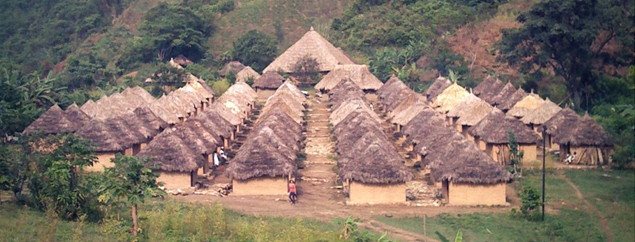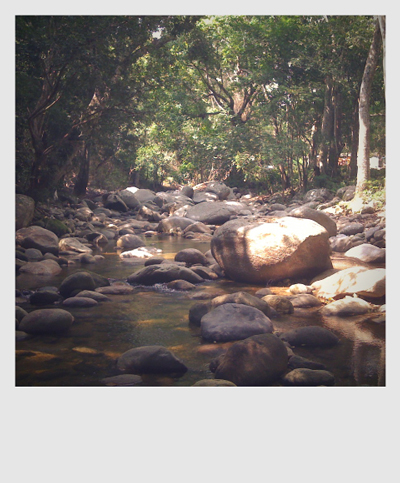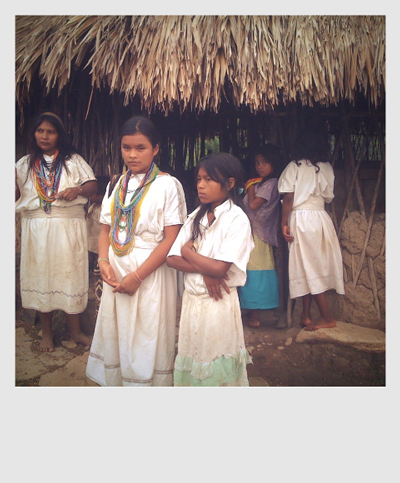
La Sabiduria de la Sierra Nevada
20 April, 2011After spending a few days in Bogota to recharge, plan and teach a couple of workshops, we have arrived to Santa Marta. We are staying at our sound engineer’s family vacation home. Their gorgeous apartment by the sea will be our base for this leg of our trip.
We are accompanied by Teto Ocampo, the legendary guitarist, multi-instrumentalist and arranger, whose work with indigenous communities around the country is the base for the project Mucho Indio and his Paleo-futuristic Laboratory.
On our first day we walked around Santa Marta, a city on the Caribbean coast. In the afternoon we went to the Don Diego river, just an hour north. We rented tubes to float down the river’s crystal clear water. The river starts high on the Sierra Nevada. Floating down a river can be a beautiful experience; you move with the rhythm of the water, feeling and hearing it; and the bird’s flight, the monkey’s swing on the trees and the countless insects’ movement all seem like a perfectly synchronised choreography. If you are lucky, you can see the impressive snow peaks of the Sierra when you arrive to the coast, where the river meets the ocean.

The Sierra Nevada is a magical mountain, which stands majestically as the highest coastal elevation on the planet. It is home to many different ecoregions that vary with elevation. The mountain is also home to Arhuaco, Kogui, Wiwa and Kankuamo communities that live in Resguardos Indigenas (Indigenous Reserves). The indigenous people of the Sierra consider it to be the heart of the world and believe that the well-being of the rest of the world depends on it. Because the Sierra contains all tropical climate areas, with its unique ecosystems, its inhabitants are aware of the imbalances of all the planet by observing the changes in their own territory. The Sierra’s ecosystems reflect the Earth’s.
The indigenous traditional territory before the Spanish colonization was much larger than it is today. The indigenous people lost land – mostly located on the lower parts by the steps of the mountains – to colonisation, tourism and farming. Many of their sacred sites, which they continue to visit today to pay offerings, are now tourist sites. Thus, there is an on-going process, partially supported by the Colombian government and various environmental and cultural organizations, of recovering the sacred territory. The process starts with buying the land back from the settlers. We were invited to one such Arhuaco village in regained territory, which was recently built at an ancient site. It is a peaceful, quiet, perfectly organised village of 20 traditionally-built houses, nested in the rainforest mountains with a pristine river nearby. The people there rarely accept visitors but we were fortunate to spend a couple of days listening to their music and playing with them.

The Arhuacos are profoundly spiritual people. They are invested in keeping the balance between humans and nature, knowing that there is no real separation between people and the environment. A vital part of their constant reciprocal relationship with nature is done singing and dancing. They dance, sing and play to communicate with nature, for healing, for concentration (gathering, meditating and discussing) and also just to have a good time. They play reed flutes and homemade snare drums, with melodies that are intricate and repetitive, accompanied by a high pitched and multi-textural singing voice. They have also adopted the accordion and armonica, which they play mostly at parties. They have countless specific songs and dances, kept from immemorial times, sang at different moments of the year and directed to specific forces of nature.
Spending time with this Arhuaco community was a moving experience. Sharing with the village kids was one of the most beautiful aspects: They are used to communal living and find it absolutely natural to share and support each other in a generous and innocent way. They pay attention to the wind, the stars, the animals and plants, just as they pay attention to each other.
When we asked how we could support their community, they gave us a specific list of tools, including machetes, shovels, picks and other tools for building. The list was long, and our limited budget doesn’t allow us to buy everything we would want to. If you want to support this community, you can send us an email and donate money through PayPal to [email protected]. We will send you pictures of the tools bought. Thanks for supporting this wise and beautiful people who have touched us so deeply.
Follow Sounds and Colours: Facebook / Twitter / Instagram / Mixcloud / Soundcloud / Bandcamp
Subscribe to the Sounds and Colours Newsletter for regular updates, news and competitions bringing the best of Latin American culture direct to your Inbox.

